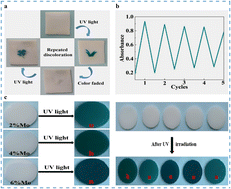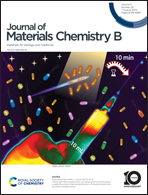Synthesis of sodium alginate/polyacrylamide photochromic hydrogels with quadruple crosslinked networks
Abstract
Photochromic hydrogels have great potential for inkless printing, smart display devices, anti-counterfeiting and encryption. However, the short information storage time limits their large-scale application. In this study, a sodium alginate/polyacrylamide photochromic hydrogel with ammonium molybdate as the color change factor was prepared. The addition of sodium alginate was beneficial to the improvement of the fracture stress and elongation at break. In particular, when the content of sodium alginate was 3%, the fracture stress increased from 20 kPa without sodium alginate to 62 kPa. Different photochromic effects and information storage times were achieved by regulating the calcium ion and ammonium molybdate concentration. And the hydrogel with an ammonium molybdate immersion concentration of 6% and calcium chloride immersion concentration of 10% can store information for up to 15 h. At the same time, the hydrogels were able to maintain their photochromic properties over five cycles of “information writing – erasure” and achieved “hunnu” encryption. Therefore, the hydrogel shows excellent information controllable erasure properties and encryption functions, indicating its broad application prospects.



 Please wait while we load your content...
Please wait while we load your content...